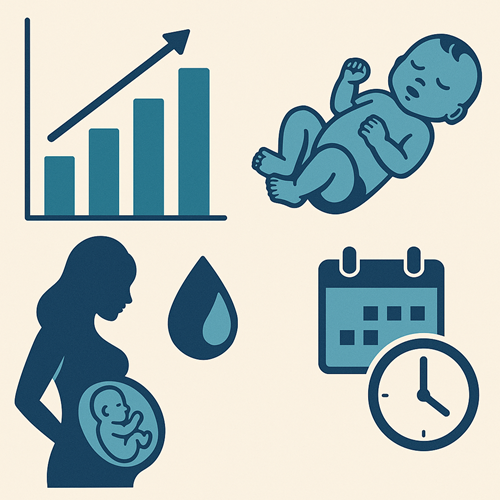No significant association between term premature rupture of membranes and neonatal APGAR score: A cross-sectional study
Abstract
Introduction: Premature rupture of membranes (PROM) is defined as the rupture of the amniotic sac before the onset of labor, potentially increasing the risk of infection, hypoxia, and a low APGAR score in newborns. The APGAR score assesses neonatal health immediately after birth and can be influenced by maternal and delivery factors, including PROM duration.
Methods: This analytical observational study used a cross-sectional design involving 119 term pregnant women with PROM, selected through purposive sampling from medical records at Dr. H. Abdul Moeloek Regional General Hospital, Lampung Province, in 2024. The independent variable was PROM duration (<12 hours or >12 hours), and the dependent variable was the neonatal APGAR score (>7 or <7). Data analysis employed the Chi-square test with a 95% confidence level.
Results: Most respondents (83.2%) experienced PROM lasting <12 hours, and 79% of newborns had APGAR scores >7. Chi-square analysis revealed no statistically significant association between PROM duration and APGAR score (p = 0.092; OR = 0.93). Although a higher proportion of low APGAR scores occurred in the >12-hour PROM group, the relationship was insignificant.
Conclusion: The study indicates no significant correlation between PROM duration in term pregnancies and neonatal APGAR scores. Prompt medical interventions may mitigate potential risks, reducing the impact of PROM duration on immediate neonatal outcomes. These findings highlight the importance of timely obstetric management and suggest further research with larger sample sizes to explore other contributing factors.
Downloads
References
Algeri, P. et al. (2025). Rupture of the membrane at term. Titled oral misoprostol: a most effective labor induction method compared to vaginal prostaglandin: Titled oral Misoprostol in tPROM induction, European Journal of Obstetrics & Gynecology and Reproductive Biology, 312, p. 114089. doi: https://doi.org/10.1016/j.ejogrb.2025.114089.
Athauda, P. et al. (2025) ‘Monitoring and timing of delivery in suspected late fetal growth restriction at term’, American Journal of Obstetrics and Gynecology. doi: https://doi.org/10.1016/j.ajog.2025.04.051.
Çarkçı Yıldız, D. and Yapar Eyi, E. G. (2025) ‘Association of Robson Ten Group Classification System with neonatal/postneonatal mortality: an analysis for the effect of the mass migration’, AJOG Global Reports, 5(2), p. 100464. doi: https://doi.org/10.1016/j.xagr.2025.100464.
Cohen, A. et al. (2024) ‘Investigation of health inequities in maternal and neonatal outcomes of patients with placenta accreta spectrum: a multicenter study’, American Journal of Obstetrics & Gynecology MFM, 6(7), p. 101386. doi: https://doi.org/10.1016/j.ajogmf.2024.101386.
Crosland, B. A. et al. (2025) ‘Amniotic fluid: its role in fetal development and beyond’, Journal of Perinatology, pp. 1–8. doi: https://dx.doi.org/10.1038/s41372-025-02313-1.
Dadkhah Tehrani, F. et al. (2021) ‘A Review on Modifications of Amniotic Membrane for Biomedical Applications’, Frontiers in Bioengineering and Biotechnology, 8, p. 606982. doi: https://dx.doi.org/10.3389/fbioe.2020.606982.
Danciu, B. M. et al. (2023) ‘Is Spontaneous Preterm Prelabor of Membrane Rupture Irreversible? A Review of Potentially Curative Approaches’, Biomedicines, 11(7), p. 1900. doi: https://dx.doi.org/10.3390/biomedicines11071900.
Feruza, N. and Wang, Z. (2023) ‘Evaluation of Puerperal and Postpartum Infections after Cesarean Section and Their Clinical Outcomes’, Open Journal of Internal Medicine, 13(04), pp. 330–350. doi: https://dx.doi.org/10.4236/ojim.2023.134030.
Getnet, A. et al. (2023) ‘Determinants of premature rupture of membrane among pregnant women in Harar town, Eastern Ethiopia: A case-control study’, Heliyon, 9(4), p. e15445. doi: https://doi.org/10.1016/j.heliyon.2023.e15445.
Ghosh, D. et al. (2025) ‘Safety and efficacy of extended expectant management in preterm premature rupture of membrane between 32 and 34 weeks of pregnancy-A randomization control trial’, European Journal of Obstetrics & Gynecology and Reproductive Biology, 310, p. 113971. doi: https://doi.org/10.1016/j.ejogrb.2025.113971.
Guerra, S. et al. (2024) ‘Megacolon diagnosis in pregnancy: A case report and literature review’, European Journal of Obstetrics & Gynecology and Reproductive Biology, 300, pp. 124–128. doi: https://doi.org/10.1016/j.ejogrb.2024.07.016.
Gunnarsdottir, J. et al. (2025) ‘Respiratory distress after planned births compared to expectant management – Target trial emulation’, European Journal of Obstetrics & Gynecology and Reproductive Biology, 307, pp. 184–190. doi: https://doi.org/10.1016/j.ejogrb.2025.02.012.
Hu, Y. et al. (2024) ‘Association between timing of labor induction and neonatal and maternal outcomes: an observational study from China’, American Journal of Obstetrics & Gynecology MFM, 6(10), p. 101456. doi: https://doi.org/10.1016/j.ajogmf.2024.101456.
Jan, M. et al. (2025) ‘Induction of labor in late-term pregnancy: amniotomy plus early oxytocin perfusion versus amniotomy plus oxytocin perfusion delayed by 24 h’, Journal of Gynecology Obstetrics and Human Reproduction, 54(1), p. 102875. doi: https://doi.org/10.1016/j.jogoh.2024.102875.
Kalifa, T. M. et al. (2024) ‘Is a pregnancy following a second trimester uterine evacuation associated with increased adverse maternal and neonatal outcomes?’, European Journal of Obstetrics & Gynecology and Reproductive Biology, 292, pp. 25–29. doi: https://doi.org/10.1016/j.ejogrb.2023.11.002.
Kong, F. et al. (2025) ‘Neonatal and maternal morbidity rates in low-risk nulliparous women across different gestational ages’, iScience, 28(4), p. 111636. doi: https://doi.org/10.1016/j.isci.2024.111636.
Liu, D. et al. (2025) ‘No difference in outcomes with early vs late antibiotic prophylaxis for term premature rupture of membranes: a multicenter analysis’, American Journal of Obstetrics and Gynecology, 233(2), pp. 129.e1-129.e13. doi: https://doi.org/10.1016/j.ajog.2025.01.017.
Lucidi, A. et al. (2024) ‘Emergency delivery in pregnancies at high probability of placenta accreta spectrum on prenatal imaging: a systematic review and meta-analysis’, American Journal of Obstetrics & Gynecology MFM, 6(10), p. 101432. doi: https://doi.org/10.1016/j.ajogmf.2024.101432.
Melikova, S., Mammadbayli, A. and Guekht, A. (2025) ‘Factors predicting seizure control and delivery outcomes in women with epilepsy with planned and unplanned pregnancy’, Revue Neurologique. Doi: https://doi.org/10.1016/j.neurol.2025.07.006.
Messinger, C. J. et al. (2025) ‘Effect of transabdominal versus transvaginal cerclage on preterm birth and neonatal outcomes among patients with a history of cervical insufficiency’, American Journal of Obstetrics and Gynecology. Doi: https://doi.org/10.1016/j.ajog.2025.06.049.
Murtado, A. et al. (2023) ‘Hubungan Ketuban Pecah Dini Terhadap Kejadian Sepsis Neonatorum Di Ruang Perinatologi Rsud Dr.H. Abdul Moeloek Provinsi Lampung’, Jurnal Ilmu Kedokteran dan Kesehatan, 10(11), pp. 3117–3122. Doi: https://dx.doi.org/10.33024/jikk.v10i11.10037.
Ospina, M. B. et al. (2025) ‘Ehawawisit: Sociodemographic, Clinical Characteristics, and Perinatal Outcomes of Métis Pregnancies in Alberta, Canada’, Journal of Obstetrics and Gynaecology Canada, p. 103044. doi: https://doi.org/10.1016/j.jogc.2025.103044.
De Preud’homme d’Hailly de Nieuport, S. M. I. et al. (2024) ‘Delayed cord clamping vs cord milking in elective cesarean delivery at term: a randomized controlled trial’, American Journal of Obstetrics & Gynecology MFM, 6(3), p. 101279. doi: https://doi.org/10.1016/j.ajogmf.2024.101279.
Rosenthal, E. A. et al. (2025) ‘Delivery timing of placenta accreta spectrum: later is feasible’, American Journal of Obstetrics and Gynecology. Doi: https://doi.org/10.1016/j.ajog.2025.02.027.
Shamim, Muhammad Aaqib et al. (2024) ‘PeRinatal, neOnatal, and Maternal OuTcomEs with azithromycin prophylaxis in pregnancy and labour (PROMOTE-PROPHYLAXIS): systematic review and meta-analysis’, eClinicalMedicine, 73, p. 102691. doi: https://doi.org/10.1016/j.eclinm.2024.102691.
Šket, T. et al. (2021) ‘The Role of Innate Immune System in the Human Amniotic Membrane and Human Amniotic Fluid in Protection Against Intra-Amniotic Infections and Inflammation’, Frontiers in Immunology, 12, p. 735324. doi: https://dx.doi.org/10.3389/fimmu.2021.735324.
Xu, L. et al. (2024) ‘Frontiers in the Etiology and Treatment of Preterm Premature Rupture of Membrane: From Molecular Mechanisms to Innovative Therapeutic Strategies’, Reproductive Sciences, 31(4), pp. 917–931. doi: https://dx.doi.org/10.1007/s43032-023-01411-9.
Yagi, S. I., Nurmalasari, Y. and Rafie, R. (2021) ‘Pengaruh Ekstrak Habbatussauda Nigella Sativa terhadap Status Gizi’, Jurnal Ilmiah Kesehatan Sandi Husada, 10(1), pp. 214–222. Doi: https://doi.org/10.35816/jiskh.v10i1.586.
Zullo, F. and Di Mascio, D. (2025) ‘Management of cervical cerclage after preterm premature rupture of membranes: an argument for removal’, American Journal of Obstetrics & Gynecology MFM, 7(1, Supplement), p. 101570. doi: https://doi.org/10.1016/j.ajogmf.2024.101570

Copyright (c) 2025 Shelvy Era Chintia, Henidekasari Henidekasari, Veronica Ela Rimawati, I Nengah Budiarta

This work is licensed under a Creative Commons Attribution 4.0 International License.




2.png)
1.png)
1.png)










